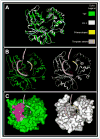Terminal deoxynucleotidyl transferase: the story of a misguided DNA polymerase
- PMID: 19596089
- PMCID: PMC2846215
- DOI: 10.1016/j.bbapap.2009.06.030
Terminal deoxynucleotidyl transferase: the story of a misguided DNA polymerase
Abstract
Nearly every DNA polymerase characterized to date exclusively catalyzes the incorporation of mononucleotides into a growing primer using a DNA or RNA template as a guide to direct each incorporation event. There is, however, one unique DNA polymerase designated terminal deoxynucleotidyl transferase that performs DNA synthesis using only single-stranded DNA as the nucleic acid substrate. In this chapter, we review the biological role of this enigmatic DNA polymerase and the biochemical mechanism for its ability to perform DNA synthesis in the absence of a templating strand. We compare and contrast the molecular events for template-independent DNA synthesis catalyzed by terminal deoxynucleotidyl transferase with other well-characterized DNA polymerases that perform template-dependent synthesis. This includes a quantitative inspection of how terminal deoxynucleotidyl transferase binds DNA and dNTP substrates, the possible involvement of a conformational change that precedes phosphoryl transfer, and kinetic steps that are associated with the release of products. These enzymatic steps are discussed within the context of the available structures of terminal deoxynucleotidyl transferase in the presence of DNA or nucleotide substrate. In addition, we discuss the ability of proteins involved in replication and recombination to regulate the activity of the terminal deoxynucleotidyl transferase. Finally, the biomedical role of this specialized DNA polymerase is discussed focusing on its involvement in cancer development and its use in biomedical applications such as labeling DNA for detecting apoptosis.
Copyright (c) 2010 Elsevier B.V. All rights reserved.
Figures











Similar articles
-
Terminal Deoxynucleotidyl Transferase in the Synthesis and Modification of Nucleic Acids.Chembiochem. 2019 Apr 1;20(7):860-871. doi: 10.1002/cbic.201800658. Epub 2019 Jan 25. Chembiochem. 2019. PMID: 30451377 Review.
-
[Conformation limited nucleoside-5'-phosphates as termination substrates for DNA-polymerases].Mol Biol (Mosk). 1989 Nov-Dec;23(6):1732-42. Mol Biol (Mosk). 1989. PMID: 2483745 Russian.
-
Labeling the 3' Termini of Oligonucleotides Using Terminal Deoxynucleotidyl Transferase.Cold Spring Harb Protoc. 2021 Aug 2;2021(8). doi: 10.1101/pdb.prot100685. Cold Spring Harb Protoc. 2021. PMID: 34341178
-
Strand annealing and terminal transferase activities of a B-family DNA polymerase.Biochemistry. 2011 Jun 14;50(23):5379-90. doi: 10.1021/bi200421g. Epub 2011 May 17. Biochemistry. 2011. PMID: 21545141
-
Applications of Terminal Deoxynucleotidyl Transferase Enzyme in Biotechnology.Chembiochem. 2023 Mar 1;24(5):e202200510. doi: 10.1002/cbic.202200510. Epub 2022 Nov 24. Chembiochem. 2023. PMID: 36342345 Review.
Cited by
-
Stealth Fluorescence Labeling for Live Microscopy Imaging of mRNA Delivery.J Am Chem Soc. 2021 Apr 14;143(14):5413-5424. doi: 10.1021/jacs.1c00014. Epub 2021 Apr 2. J Am Chem Soc. 2021. PMID: 33797236 Free PMC article.
-
Template-switching mechanism of a group II intron-encoded reverse transcriptase and its implications for biological function and RNA-Seq.J Biol Chem. 2019 Dec 20;294(51):19764-19784. doi: 10.1074/jbc.RA119.011337. Epub 2019 Nov 11. J Biol Chem. 2019. PMID: 31712313 Free PMC article.
-
The recombinase activating genes: architects of immune diversity during lymphocyte development.Front Immunol. 2023 Jul 11;14:1210818. doi: 10.3389/fimmu.2023.1210818. eCollection 2023. Front Immunol. 2023. PMID: 37497222 Free PMC article. Review.
-
Novel enzymatic single-nucleotide modification of DNA oligomer: prevention of incessant incorporation of nucleotidyl transferase by ribonucleotide-borate complex.Nucleic Acids Res. 2019 Sep 26;47(17):e102. doi: 10.1093/nar/gkz612. Nucleic Acids Res. 2019. PMID: 31318972 Free PMC article.
-
De novo DNA synthesis using polymerase-nucleotide conjugates.Nat Biotechnol. 2018 Aug;36(7):645-650. doi: 10.1038/nbt.4173. Epub 2018 Jun 18. Nat Biotechnol. 2018. PMID: 29912208
References
-
- Bollum FJ. Thermal conversion of nonpriming deoxyribonucleic acid to primer. J Biol Chem. 1959;234:2733–2734. - PubMed
-
- Bollum FJ. Chemically Defined Templates and Initiators for Deoxypolynucleotide Synthesis. Science. 1964;144:560. - PubMed
-
- Bollum FJ. Calf thymus polymerase. J Biol Chem. 1960;235:2399–2403. - PubMed
-
- Gilfillan S, Dierich A, Lemeur M, Benoist C, Mathis D. Mice lacking TdT: mature animals with an immature lymphocyte repertoire. Science. 1993;261:1175–1178. - PubMed
Publication types
MeSH terms
Substances
Grants and funding
LinkOut - more resources
Full Text Sources
Other Literature Sources

